Pluto 350
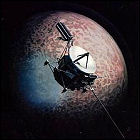 Encouraged by the public interest in Voyager 2’s recent visit to Neptune, scientist Robert Farquhar and graduate student Alan Stern pitch a concept for a compact mission, using hardware derived from the Voyager program, to the planet Pluto. Named Pluto 350, for the 350-kilogram upper weight limit decided on as a feasible and affordable launch weight, their proposed mission would launch in November 2001, have a close encounter with asteroid 1442 Corvina in 2002, then a return to Earth to catch a gravity assist in 2005, with a further gravity assist at Jupiter boosting Pluto 350 to its final target in 2015. In addition to pitching this plan to NASA, Farquhar and Stern appeal to the public by publishing a detailed six-page mission plan in the pages of the Planetary Society’s newsletter. However, a tendency toward larger spacecraft – such as the Mariner Mark II architecture envisioned for the upcoming Cassini and CRAF missions – means that Pluto 350 is not given serious consideration by NASA.
Encouraged by the public interest in Voyager 2’s recent visit to Neptune, scientist Robert Farquhar and graduate student Alan Stern pitch a concept for a compact mission, using hardware derived from the Voyager program, to the planet Pluto. Named Pluto 350, for the 350-kilogram upper weight limit decided on as a feasible and affordable launch weight, their proposed mission would launch in November 2001, have a close encounter with asteroid 1442 Corvina in 2002, then a return to Earth to catch a gravity assist in 2005, with a further gravity assist at Jupiter boosting Pluto 350 to its final target in 2015. In addition to pitching this plan to NASA, Farquhar and Stern appeal to the public by publishing a detailed six-page mission plan in the pages of the Planetary Society’s newsletter. However, a tendency toward larger spacecraft – such as the Mariner Mark II architecture envisioned for the upcoming Cassini and CRAF missions – means that Pluto 350 is not given serious consideration by NASA.

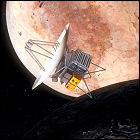 NASA and JPL announce a plan is in the works to launch small twin spacecraft toward the planet Pluto. The Pluto Fast Flyby mission would launch two vehicles in 1997 or 1998, much smaller than the Voyager spacecraft that have explored the larger outer planets, with the two vehicles possibly arriving at Pluto as early as 2005 or 2007. Pluto Fast Flyby has the support of NASA’s new administrator and the White House, both of whom are insisting that NASA embrace a “faster, better, cheaper” space exploration philosophy. To save weight and energy, the initial mission proposal calls for no instruments other than cameras. This meets with protests from scientists (and proponents of the earlier
NASA and JPL announce a plan is in the works to launch small twin spacecraft toward the planet Pluto. The Pluto Fast Flyby mission would launch two vehicles in 1997 or 1998, much smaller than the Voyager spacecraft that have explored the larger outer planets, with the two vehicles possibly arriving at Pluto as early as 2005 or 2007. Pluto Fast Flyby has the support of NASA’s new administrator and the White House, both of whom are insisting that NASA embrace a “faster, better, cheaper” space exploration philosophy. To save weight and energy, the initial mission proposal calls for no instruments other than cameras. This meets with protests from scientists (and proponents of the earlier 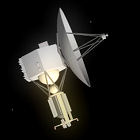 With NASA/JPL’s Pluto Fast Flyby mission cancelled, a new mission is proposed by several scientists and engineers, including veterans of the Voyager program, to send a small spacecraft to Pluto. Originally named Pluto Express, and later Pluto-Kuiper Express, the unmanned spacecraft would be armed with a handful of scientific instruments (as opposed to Pluto Fast Flyby’s camera-only proposal). Plans call for launch via a Delta Heavy rocket or from the cargo bay of a Space Shuttle in 2004, a Jupiter gravity assist flyby in 2006, and a Pluto flyby in 2012. Though there are early talks with the Russian space program about including landers or penetrators, that element of the mission is dropped soon afterward.
With NASA/JPL’s Pluto Fast Flyby mission cancelled, a new mission is proposed by several scientists and engineers, including veterans of the Voyager program, to send a small spacecraft to Pluto. Originally named Pluto Express, and later Pluto-Kuiper Express, the unmanned spacecraft would be armed with a handful of scientific instruments (as opposed to Pluto Fast Flyby’s camera-only proposal). Plans call for launch via a Delta Heavy rocket or from the cargo bay of a Space Shuttle in 2004, a Jupiter gravity assist flyby in 2006, and a Pluto flyby in 2012. Though there are early talks with the Russian space program about including landers or penetrators, that element of the mission is dropped soon afterward.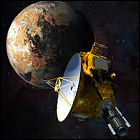 In response to a NASA request for mission proposals a month earlier, Southwest Research Institute scientist Dr. Alan Stern and a group of other scientists and engineers who had been working on the now-cancelled Pluto-Kuiper Express mission submit a nearly-identical proposal to NASA for a Pluto/Kuiper Belt mission called New Horizons. Very much like Pluto-Kuiper Express, New Horizons calls for a single small spacecraft to launch early in the 21st century, and, after a gravity assist from a Jupiter flyby, a Pluto encounter 10-11 years after launch. Some of the program costs are streamlined in the new proposal to make this iteration of the long-delayed Pluto mission more appealing to NASA, although New Horizons would carry more scientific payload than any previously envisioned Pluto expedition. Another proposal, Pluto and Outer Solar System Explorer (POSSE), is also submitted to NASA.
In response to a NASA request for mission proposals a month earlier, Southwest Research Institute scientist Dr. Alan Stern and a group of other scientists and engineers who had been working on the now-cancelled Pluto-Kuiper Express mission submit a nearly-identical proposal to NASA for a Pluto/Kuiper Belt mission called New Horizons. Very much like Pluto-Kuiper Express, New Horizons calls for a single small spacecraft to launch early in the 21st century, and, after a gravity assist from a Jupiter flyby, a Pluto encounter 10-11 years after launch. Some of the program costs are streamlined in the new proposal to make this iteration of the long-delayed Pluto mission more appealing to NASA, although New Horizons would carry more scientific payload than any previously envisioned Pluto expedition. Another proposal, Pluto and Outer Solar System Explorer (POSSE), is also submitted to NASA.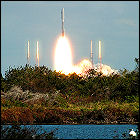 NASA launches the unmanned New Horizons probe on a course for the minor planet Pluto, the first spacecraft built to explore that destination. A trajectory with multiple planetary flybys and gravitational assists is designed to sling New Horizons toward Pluto within a decade (compared to Voyager 2’s 12-year trek to Neptune).
NASA launches the unmanned New Horizons probe on a course for the minor planet Pluto, the first spacecraft built to explore that destination. A trajectory with multiple planetary flybys and gravitational assists is designed to sling New Horizons toward Pluto within a decade (compared to Voyager 2’s 12-year trek to Neptune).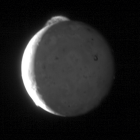 NASA’s New Horizons probe, on a one-way trip to become the first probe to swing past distant Pluto, picks up speed dramatically as it slingshots past Jupiter. New Horizons sensors are trained on the giant planet to get the first look at Jupiter since Galileo swan-dived into its crushing atmosphere. New Horizons gains nearly 9,000 miles per hour as it swings past Jupiter, which will put it at Pluto in July 2015. New Horizons’ camera catches an erupting volcano on Jupiter’s moon Io, spewing material 200 miles above the surface.
NASA’s New Horizons probe, on a one-way trip to become the first probe to swing past distant Pluto, picks up speed dramatically as it slingshots past Jupiter. New Horizons sensors are trained on the giant planet to get the first look at Jupiter since Galileo swan-dived into its crushing atmosphere. New Horizons gains nearly 9,000 miles per hour as it swings past Jupiter, which will put it at Pluto in July 2015. New Horizons’ camera catches an erupting volcano on Jupiter’s moon Io, spewing material 200 miles above the surface.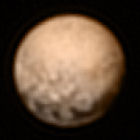 NASA’s New Horizons abruptly loses contact with Earth-based ground controllers and then signals that it has gone into safe mode, ten days before its closest flyby of Pluto. In this mode, the spacecraft gathers no scientific data, and awaits intervention from Earth, but its distance from Earth – four billion miles away – means that signals transmitted to or from New Horizons take four and a half hours to reach their destination (and any reply takes just as long). A timing error is located in New Horizons’ automatic event sequencer, a vital part of its mission since it will need to operate independently to conduct hundreds of observations of Pluto and its satellites with no contact from Earth until later, and the probe is rebooted within 48 hours. Though the probe’s automatic switch to failsafe mode has cost the mission some scientific observations, most of the high-value data will not be collected until within 24 hours of closest approach on July 14th.
NASA’s New Horizons abruptly loses contact with Earth-based ground controllers and then signals that it has gone into safe mode, ten days before its closest flyby of Pluto. In this mode, the spacecraft gathers no scientific data, and awaits intervention from Earth, but its distance from Earth – four billion miles away – means that signals transmitted to or from New Horizons take four and a half hours to reach their destination (and any reply takes just as long). A timing error is located in New Horizons’ automatic event sequencer, a vital part of its mission since it will need to operate independently to conduct hundreds of observations of Pluto and its satellites with no contact from Earth until later, and the probe is rebooted within 48 hours. Though the probe’s automatic switch to failsafe mode has cost the mission some scientific observations, most of the high-value data will not be collected until within 24 hours of closest approach on July 14th.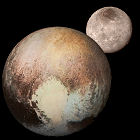 Nine years after its launch from Earth, NASA’s New Horizons space probe passes within 8,000 miles of the surface of Pluto, and within 18,000 miles of Pluto’s largest moon, Charon. Detailed images and observations are obtained of both of these bodies, with less detailed data gathered on Pluto’s four smaller, outermost moons. Cruising through the Pluto system at 30,000 miles per hour, New Horizons must break contact with Earth for nearly a full day to aim its cameras and other instruments at their targets. It’s not until some 12 hours after the point of closest flyby that New Horizons re-establishes contact with Earth, reporting that it has successfully completed the encounter with no problems.
Nine years after its launch from Earth, NASA’s New Horizons space probe passes within 8,000 miles of the surface of Pluto, and within 18,000 miles of Pluto’s largest moon, Charon. Detailed images and observations are obtained of both of these bodies, with less detailed data gathered on Pluto’s four smaller, outermost moons. Cruising through the Pluto system at 30,000 miles per hour, New Horizons must break contact with Earth for nearly a full day to aim its cameras and other instruments at their targets. It’s not until some 12 hours after the point of closest flyby that New Horizons re-establishes contact with Earth, reporting that it has successfully completed the encounter with no problems. Picador publishes the non-fiction book
Picador publishes the non-fiction book 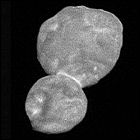 NASA’s New Horizons space probe, operated by Johns Hopkins University’s Applied Physics Lab, passes within 2,200 miles of the mysterious Kuiper Belt object 2014 MU69, a tiny fragment of leftover material from the birth of the solar system. Previously seen only as a tiny pixel even by the powerful lens of the Hubble Space Telescope, nothing was known of 2014 MU69 prior to the flyby, which revealed it as a contact binary: two bodies which had become gravitationally fused together. As 2014 MU69 (informally nicknamed Ultima Thule in a public poll conducted by the New Horizons public outreach team) is a billion miles further away than Pluto, and with New Horizons continuing outward at 30,000 miles per hour, signals between Earth and New Horizons take at least six hours to reach their destination, so the downlink of data from the flyby would take until 2020 to complete.
NASA’s New Horizons space probe, operated by Johns Hopkins University’s Applied Physics Lab, passes within 2,200 miles of the mysterious Kuiper Belt object 2014 MU69, a tiny fragment of leftover material from the birth of the solar system. Previously seen only as a tiny pixel even by the powerful lens of the Hubble Space Telescope, nothing was known of 2014 MU69 prior to the flyby, which revealed it as a contact binary: two bodies which had become gravitationally fused together. As 2014 MU69 (informally nicknamed Ultima Thule in a public poll conducted by the New Horizons public outreach team) is a billion miles further away than Pluto, and with New Horizons continuing outward at 30,000 miles per hour, signals between Earth and New Horizons take at least six hours to reach their destination, so the downlink of data from the flyby would take until 2020 to complete.